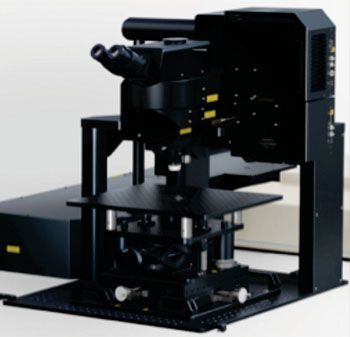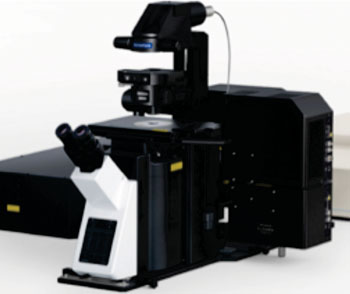New Multiphoton Laser Scanning Microscope Configurations Expand Research Potential
By LabMedica International staff writers
Posted on 19 Feb 2015
Two new configurations of a state-of-the-art multiphoton laser scanning microscope extend the usefulness of the instrument for examining rapidly occurring biological events and for obtaining images from within cell cultures and tissues.Posted on 19 Feb 2015
Olympus (Hamburg, Germany) has released two new configurations of the FLUOVIEW FVMPE-RS microscope series, a Gantry microscope system and an inverted microscope system.
In multiphoton microscopy, fluorescence excitation efficiency is maximized by using a short pulse width in the focal plane. However, the pulse width of a femtosecond laser disperses as it passes through optics, broadening the pulse width when the beam exits from an objective. The laser beam-shaping optics establishes a compensatory dispersion, the exact inverse of that produced by the microscope’s optics, thus restoring the ideal pulse width for the specimen.
The high-speed scanner, which is the core of the FLUOVIEW FVMPE-RS, enables observation of ultra-rapid biological responses and can obtain vivid images from as deep as eight millimeters below the tissue surface. This is possible because the 25x water immersion objective with a working distance of two millimeters delivers a high resolution and a wide field of view for deep observation of live specimens. Other objectives in the same family with working distances of four millimeters and eight millimeters deliver maximum performance with fixed transparent specimens for high-definition observation at deep levels and accommodating various immersion solutions. All of these objectives feature correction collars that allow them to correct spherical aberration generated by the difference in refractive index between the immersion solution and the specimen—forming optimal light-condensed spots without energy density loss, even during observations deep within the specimen. In addition, each objective features a wide field design that permits the efficient acquisition of scattered fluorescence photons for bright observations.
The Gantry microscope version features an ultra-stable arch-like structure with considerable space beneath the objective to accommodate samples of varied sizes. A volume 640 millimeters wide, 355 millimeters high, and 520 millimeters deep becomes available if the stage is removed, which allows flexibility to suit different observation purposes.
The configuration of the inverted microscope system has been optimized for observation of cells in three-dimensional cultures, where multiple layers of cells are cultured in a Petri dish or similar vessel. As the objective of the inverted microscope approaches the sample from below, cells that have adhered to the base of the Petri dish can be observed without culture fluid touching the objective.
Related Links:
Olympus
















